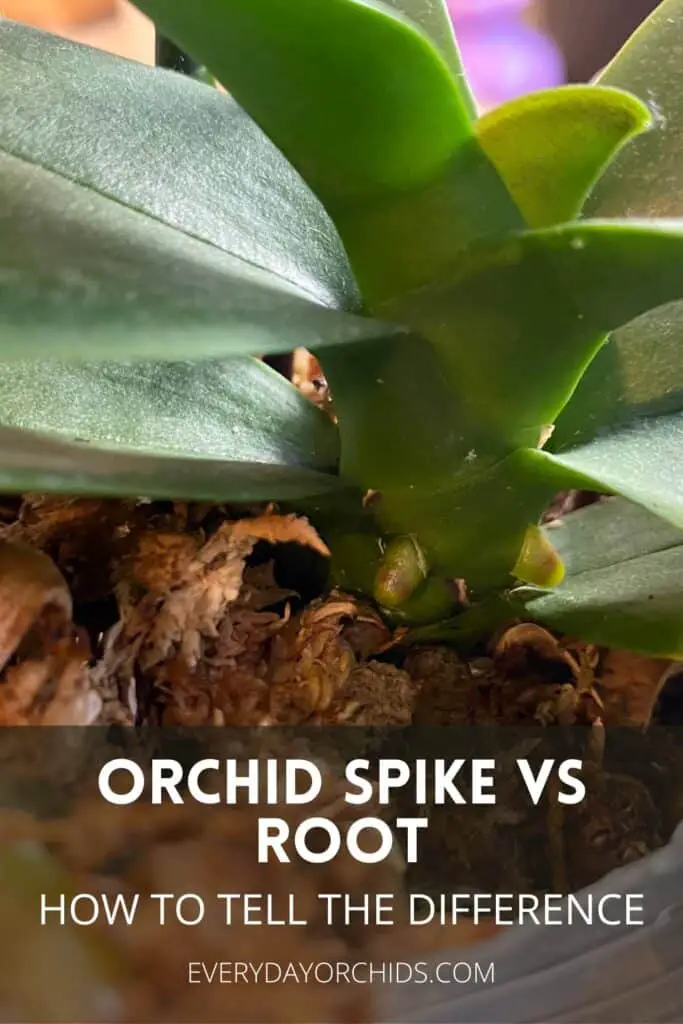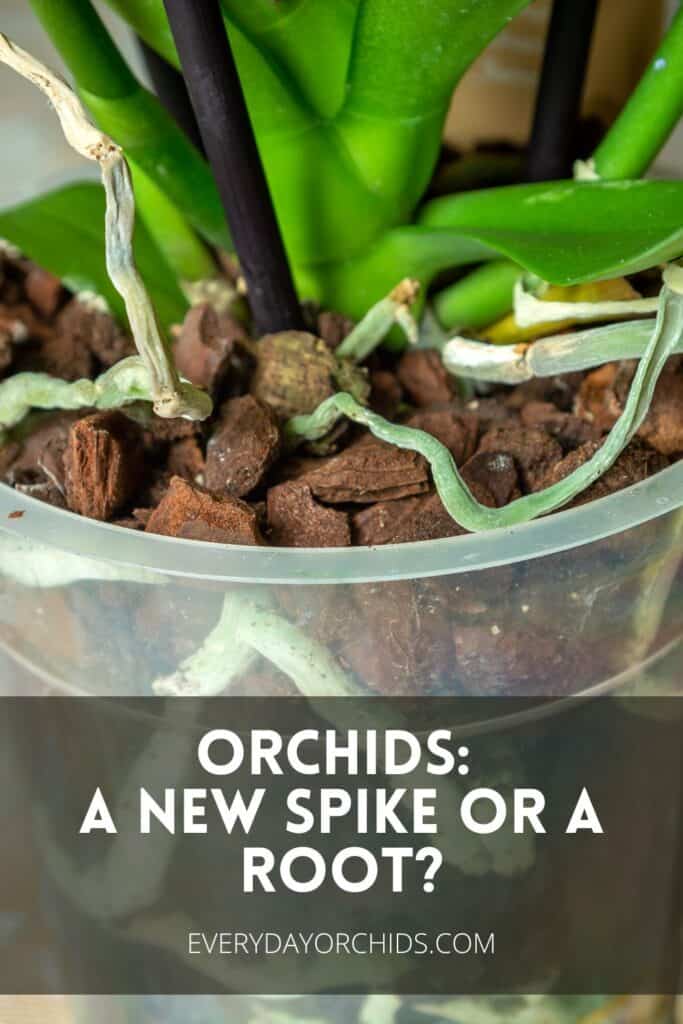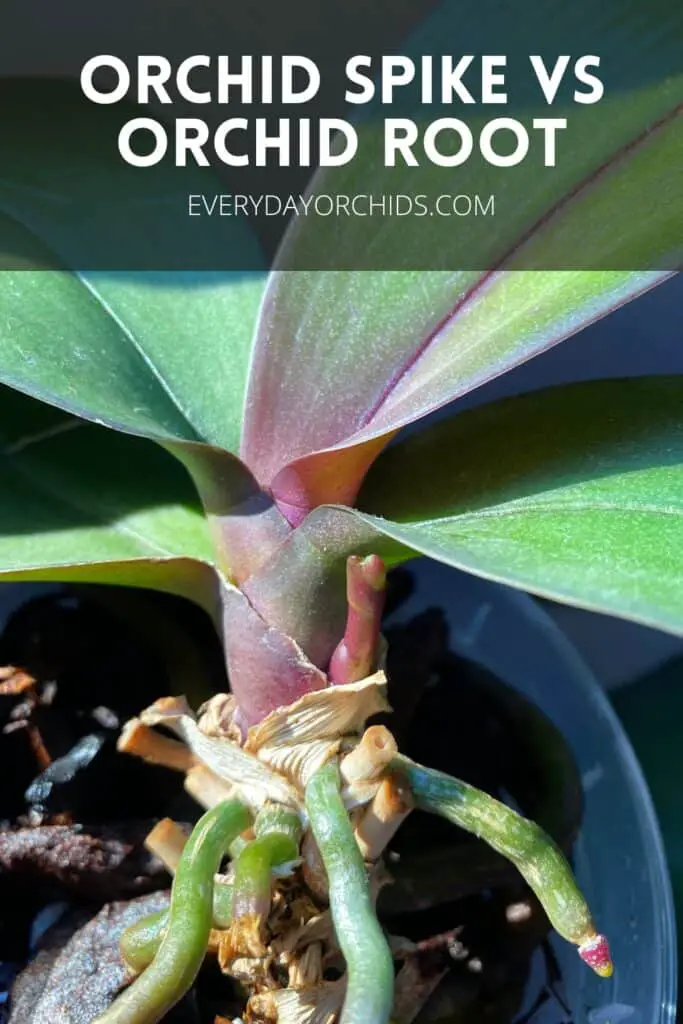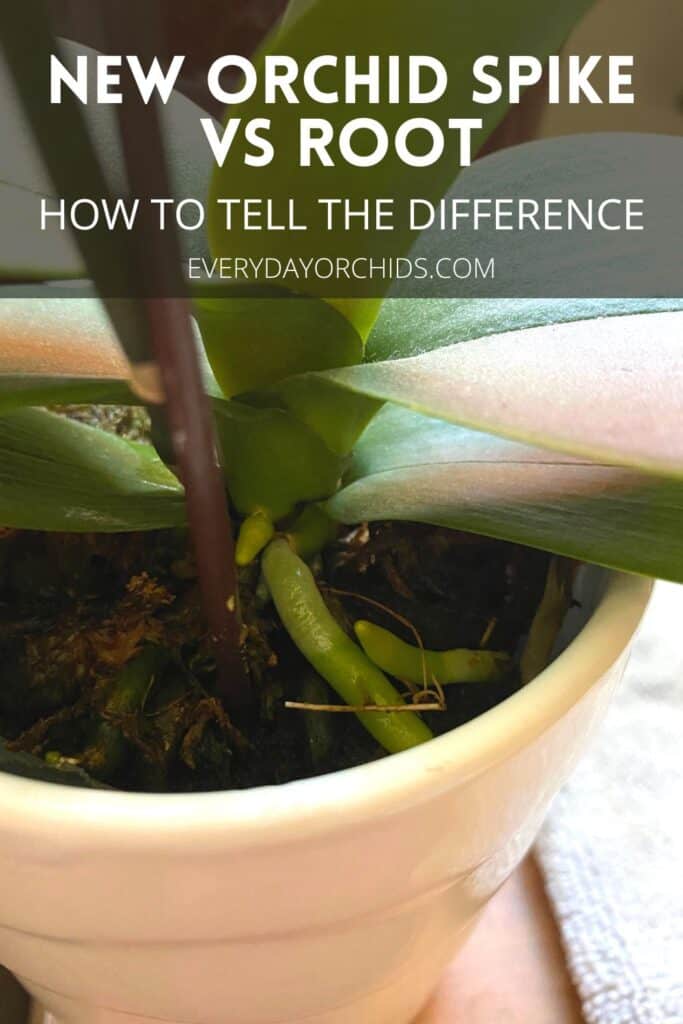How do you tell a new spike from a root on an orchid? When you find new growth on your orchid, you may be wondering what you are looking at. There are a few key differences that will help you spot an orchid flower spike vs a root.
A new orchid flower spike will look like a little “mitten,” and be pointed upward. A new orchid root does not have a “mitten,” but rather has a rounded tip. A root bud typically will grow downwards or straight out.
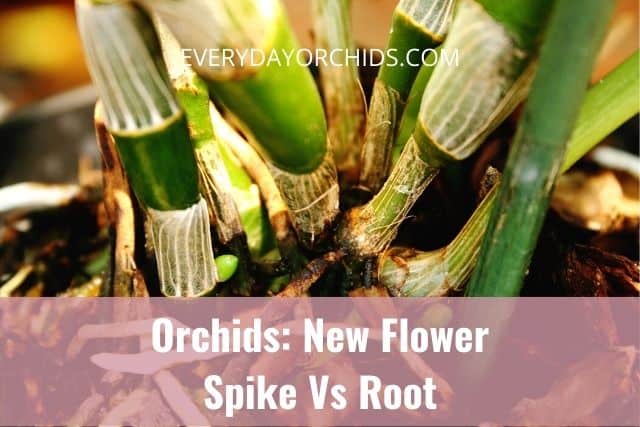
Recognizing new orchid growth and being able to differentiate between a new orchid spike vs a root is helpful for any orchid grower. It will help guide your orchid care moving forward.
I’ll go over those differences in more detail next, along with how fast you can expect growth for a new spike vs root. Keep reading to learn more.
Please note that these links are affiliate links and as an Amazon Associate, I earn from qualifying purchases. Purchases made through affiliate links in this post may generate commissions at no additional cost to you. Use this link for a discounted Amazon Prime trial. Thank you for your support!
Table of Contents
How To Recognize New Orchid Flower Spikes
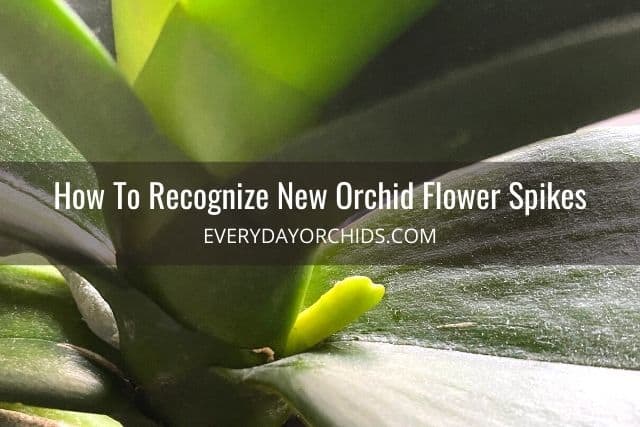
If your orchid has new growth, congratulations! It is a sign that you are doing something right. But wait, how do you tell if that new growth is a flower spike vs a root?
It is easier to recognize flower spikes in some orchids, mainly because of where they develop.
For example, in sympodial orchids, such as Oncidiums or Miltoniopsis orchids, flower spikes grow out from the top of the pseudobulbs. You’ll see a flower spike emerge from among a cluster of leaves. In reed orchids like Epidendrum orchids, flower spikes grow from the top of the reed stem.
Much of the confusion about new spike vs root has to do with Phalaenopsis orchids.
This is because the flower spikes and roots develop in the same area. They are also initially the same color. With that in mind, I will mainly focus on Phalaenopsis orchids in this article.
In Phalaenopsis orchids, new flower spikes can appear at the base of the orchid’s main stem, in between the leaves or even in the middle of the orchid’s crown.
These new flower spikes are often green in color, similar to root buds, making it hard to tell them apart.
Below is a picture of one of my orchids with a new flower spike. You see how initially, it can be hard to tell it apart from a root?
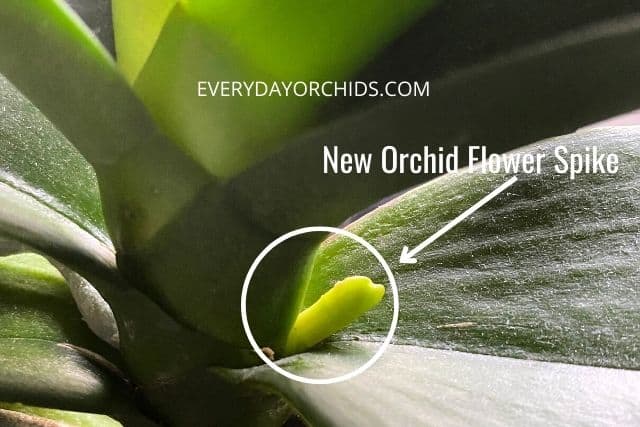
The key difference between a new spike and a root is that Phalaenopsis orchid flower spikes have a little mitten-shaped tip. They are also a brighter green color and are a bit flatter at the mitten tip.
Look closer at the new spikes in the picture above and below. You can see a little mitten shape.
Some new orchid flower spikes may be red in color, as pictured in my orchid below. This is because of genetics. My orchid that produces these reddish flower spikes also produces reddish roots, and this is totally normal.
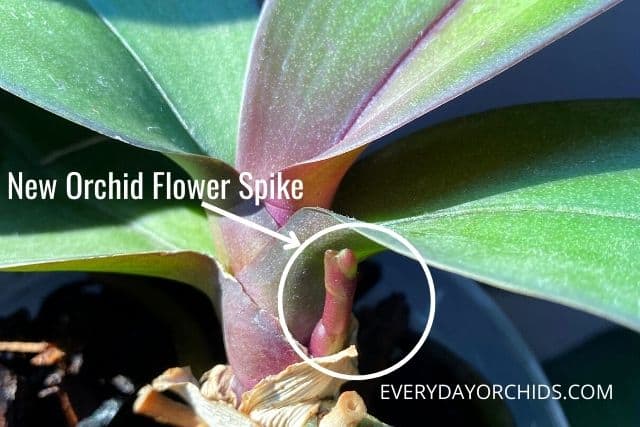
As the flower spike grows and elongates, you will start to clearly see nodes and other distinguishing features that sets it apart from an orchid root.
Terminal Spikes
A quick word about terminal flower spikes. If you see a flower spike in the middle of the orchid’s crown, this is often called a “terminal spike.”
An orchid can develop a terminal spike for a number of reasons, including insufficient lighting, inadequate fertilization, or because it is simply near the end of its lifespan.
If the orchid is near the end of its life, there is not much you can do about it. The orchid probably will be around for another 2 or 3 years, but it will not be producing any new leaves or roots.
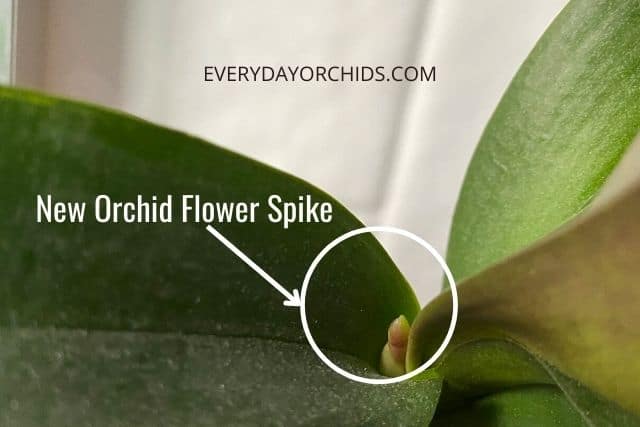
Sometimes the orchid will also develop a keiki on the flower spike. This is the orchid’s last ditch effort at passing on its genetic material.
If you see this happening, keep caring for your orchid as you normally would. Leave the keiki on the flower spike until the roots are 2-3 inches long and it is large enough to be safely removed. You can read more about how to care for orchid keiki here.
Of note, terminal spikes in some orchid species, such as Paphiopedilum orchids, are considered normal and NOT a sign that the orchid is nearing the end of it’s life.
Orchid Flower Spike Growth
In terms of how fast flower spikes grow, you can expect a Phalaenopsis orchid flower spike to take up to 3 months to fully grow. This includes the moment the new spike first emerges on the orchid’s main stem to when the buds open and the flowers bloom. So, from start to finish, you are looking at 3 months.
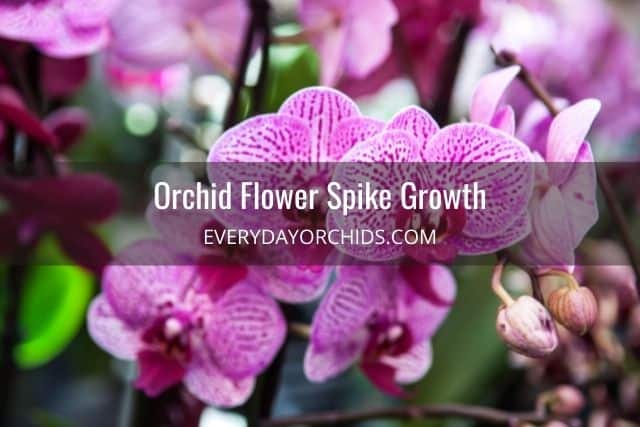
Orchid Location
When you see a new flower spike start to develop on an orchid, you’ll want to pay attention to the location of the orchid in your home. Make sure it is getting enough light. You also want to make sure the orchid pot is where you want it to be.
Once the flower spike starts to grow, avoid turning the orchid pot or changing the orchid’s location.
In other words, leave it where it is. The orchid’s flower spike will grow in the direction of the light. Moving it from place to place and changing the direction of the lighting will result in twisted or malformed flower spikes.
Staking The Spike
Once a flower spike grows to several inches in length, you will want to start thinking about staking the spike.
When you stake a flower spike, you are providing it with the support it needs to continue growing. Phalaenopsis orchids, in particular, can get top heavy.
Staking the flower spike will help prevent the flower spike from leaning too far to one side or breaking from the weight of the blooms.
For more information, read this guide on how to properly stake your orchid.
Blooming And Reblooming Your Orchid
Some orchids will develop multiple flower spikes each blooming season, whereas other orchids will only develop one flower spike per year. The age of the orchid plays a role in this.
Older, more mature, established orchids tend to grow multiple flower spikes. Younger orchids tend to only develop one flower spike each year.
Using a bloom booster orchid fertilizer during the fall, or in the months leading up to the blooming season, will help your orchid produce more blooms. Bloom booster fertilizer contains higher levels of phosphorus, which is necessary for bloom production.
Orchids can also grow secondary flower spikes from a node on an existing flower spike. In general, if your orchid’s flower spike is still green and healthy-appearing, don’t cut it off, even if it has lost all the flowers already.
There is a chance that another flower spike may grow, branching off from the existing spike. There are ways you can prune your orchid’s spike to help make this happen. You can read more about how to get your orchid to bloom and rebloom here.
How To Spot Orchid Root Buds
Now that I’ve described what new orchid flower spikes look like, let’s talk about new orchid roots. In this picture below, you can see an orchid keiki growing on a Dendrobium orchid cane. As you can see, the keiki has developed little root buds.
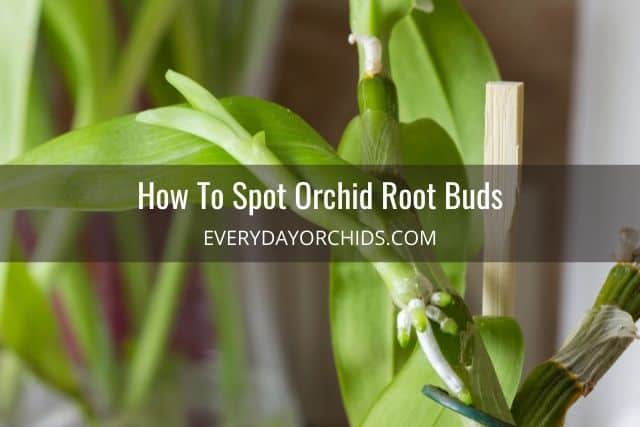
In sympodial orchids such as Oncidiums and Miltoniopsis orchids, new root buds will appear at the base of pseudobulbs. These root buds are white and thin and easier to spot.
Reed orchids, such as Epidendrum orchids, also develop thin, white root buds. These can be found near the base of the reed stem.
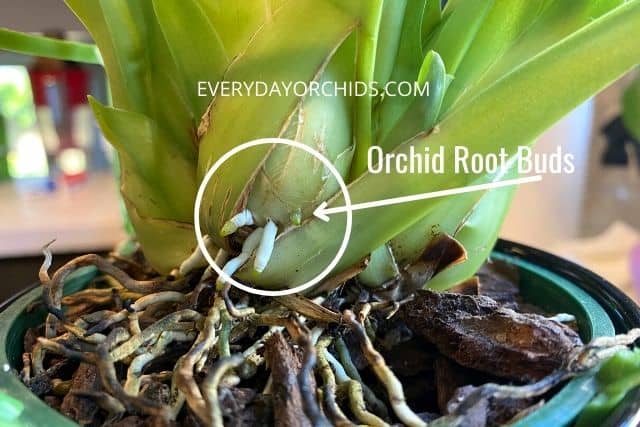
In Phalaenopsis orchids, new orchid root buds will mainly appear at the base of the orchid’s main stem.
For these particular orchids, root buds can be green in color. When you are comparing a new orchid spike vs root, this color is similar to the color of new flower spikes. As a result, it can be difficult to initially distinguish between the two.
Below is a picture of one of my orchids with two new root buds emerging near the base of the main stem.

In Phalaenopsis orchids, the green root buds can be distinguished from a new flower spike by the shape. Root buds have a symmetrical, rounded tip that can be either green or red, depending on genetics.
Below is a picture of one of my orchids which has a red-purple colored root bud forming. This orchid also makes red-toned flower spikes (pictured in the section above).

As for Phalaenopsis orchids with green root buds, you will notice when comparing a new orchid spike vs root, the shade of green will be different. Green root buds tend to be a darker green than the green you’d see on new flower spikes.
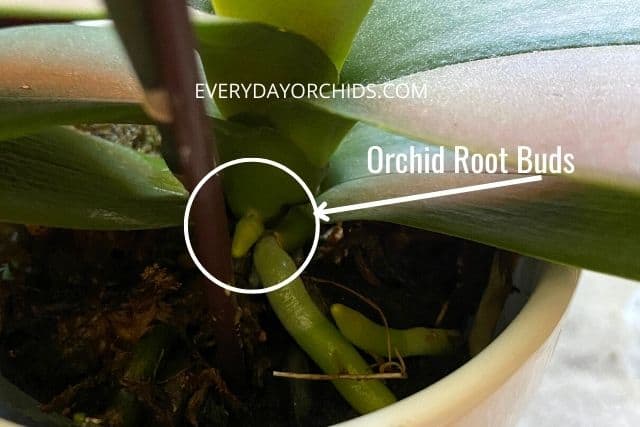
In addition, root buds have a distinguishing light gray, silvery covering (velamen) that develops along the root. Initially, you’ll see the velamen on the part of the root closest to the main stem.
Velamen is important for absorbing water and moisture for the orchid. As the root grows, the silvery velamen will also extend out, covering all but the tip of the root.
Root buds tend to develop at the base of the orchid’s main stem under the lowest leaves.
These root buds will go on to become aerial roots that grow up and around the orchid or roots that grow down into the potting media.
Orchid Root Growth
So now that you have root buds on your orchid, you may be wondering, how fast do orchid roots grow?
Orchid roots can take anywhere from 1 to 2 months to fully grow, depending on the season and growing conditions.

During the summer months, when the weather is warm and growing season is in full swing, roots will grow and develop more quickly.
During the winter, the growth rate will slow down considerably. Some orchids even experience a dormant period during the colder months, where growth slows down so much that it is barely noticeable.
When you notice those new root buds, keep caring for your orchid as you normally would. Make sure it has adequate lighting, watering, humidity and fertilization. You can read more about how fast orchids grow here.
Final Thoughts
It will take some practice but pretty soon, the question of new orchid spike vs root will no longer be an issue for you. You’ll be able to tell a new orchid spike from a new orchid root bud. There are distinguishing characteristics each one has to help you differentiate between them.
That said, any new growth on your orchid, whether it is a new spike, root, or leaf, is a good sign. It proves that you are doing something right with your orchid care. Take heart in that and keep up the good work. As always, happy orchid growing!

